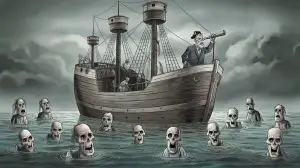Is it a spooky myth or just high seas bad luck?
For decades, the Bermuda Triangle has baffled and intrigued both skeptics and adventurers alike. This area in the western part of the North Atlantic Ocean, roughly defined by Miami, Bermuda, and Puerto Rico, has been the site of numerous mysterious disappearances of ships and planes over the years.

The mystery of the Bermuda Triangle has captivated imaginations since the mid-20th century. From the disappearance of the U.S.S. Cyclops, a Navy supply ship, in 1918, to more modern-day vanishings, the stories surrounding this area are shrouded in unanswered questions.
What’s behind these cryptic events? Is it human error, environmental factors, or something more otherworldly?
For those fascinated by unsolved mysteries and oceanic tales, the Bermuda Triangle offers a perfect blend of science, legend, and a touch of the supernatural.
As one of the most heavily traveled shipping lanes in the world, its allure continues to draw curiosity from people all over the globe.
Dive in as we explore the enigmatic depths of the Bermuda Triangle.
History and Background
The Bermuda Triangle, also known as the Devil’s Triangle, is a mysterious area in the North Atlantic Ocean where numerous ships and aircraft have disappeared.
Let’s dig into its intriguing past and how it gained its infamous reputation.
Early Accounts
Christopher Columbus is one of the earliest figures linked to the Bermuda Triangle.
During his first voyage to the New World in 1492, he noted strange compass readings and a burst of flames in the sky. This has been one of the first recorded mysteries of the region.
In 1918, the USS Cyclops, a massive Navy cargo ship, vanished without a trace along with its 309 crew members. Despite extensive searches, no wreckage was found. This disappearance further fueled speculation about the area.
World War II brought more attention.
Flight 19, a group of five U.S. Navy bombers, got lost during a training mission in 1945. The planes and their 14 airmen never returned. Investigations suggested they likely ran out of fuel, but the event remains shrouded in mystery.
Rise to Fame
The term “Bermuda Triangle” was popularized in 1964 when writer Vincent Gaddis used it in a magazine article.
He described the area as a dead zone for ships and planes, drawing public interest.
In the 1970s, Charles Berlitz’s book “The Bermuda Triangle” became a bestseller. He linked the disappearances to paranormal activity and extraterrestrial involvement, capturing the public’s imagination.
Berlitz’s work built on sensationalist accounts, further engraining the legend in popular culture.
The Bermuda Triangle gained more attention through pulp magazines and TV shows, cementing its place as a fascinating maritime mystery. While many theories abound, the area remains one of the ocean’s great enigmas, captivating curious minds worldwide.
Geographic Boundaries

The Bermuda Triangle is an intriguing section of the Atlantic Ocean that connects specific locations like Florida, Bermuda, and Puerto Rico. Each corner of this loosely defined triangle has its own unique significance.
Defining the Triangle
The Bermuda Triangle stretches between Miami in Florida, Bermuda island, and San Juan in Puerto Rico. These points create a triangular shape in the North Atlantic Ocean.
The area is known for mysterious disappearances of ships and aircraft.
While specific boundaries aren’t agreed upon, many link the region to legends and myths. This fascinating area covers roughly 500,000 to 1.5 million square miles.
Miami, Bermuda, and San Juan all add unique elements to this mystery, making it one of the most talked-about oceanic regions in the world.
Notable Disappearances
The Bermuda Triangle has been a hotspot for mysterious vanishings of both sea vessels and aircraft. These incidents have puzzled experts and sparked numerous theories over the years.
Sea Vessels
The Mary Celeste: One of the most famous cases involved the Mary Celeste, which was found abandoned in 1872. Everything on board was in order, except for the missing crew. There were no signs of struggle, and the ship’s cargo was intact. The fate of the crew remains a mystery.
USS Cyclops: Another significant disappearance was the USS Cyclops in 1918. This naval ship, carrying over 300 people and a large amount of manganese ore, vanished without a trace on its way to Baltimore. Despite an extensive search, neither wreckage nor survivors were ever found.
Carroll A. Deering: In 1921, the Carroll A. Deering was discovered off the coast of North Carolina. The ship was deserted, and the lifeboats were missing, but supplies were stockpiled. Like the Mary Celeste, what happened to the crew is still unknown.
Aircraft
Flight 19: In 1945, five US Navy Avenger torpedo-bombers, known as Flight 19, disappeared during a routine training mission. The planes, along with a rescue aircraft sent to find them, left no clues. This incident has fueled many theories about the Triangle’s mysteries.
Thomas Arthur Garner: On July 10, 1945, Thomas Arthur Garner and 11 other crew members disappeared in a PBM3S patrol seaplane. They left from Banana River, Florida, for a radar training flight and never returned. Searches found no evidence of the plane or its crew.
Science and Explanations
The Bermuda Triangle has long been a topic of intrigue. Science points to natural phenomena and human errors to explain the mysterious occurrences in the region.
Natural Phenomena
Storms are common in the Bermuda Triangle.
The area is known for its unpredictable weather, with hurricanes and sudden thunderstorms. These can lead to shipwrecks and plane crashes quickly.
Another factor is rogue waves. These are giant waves that can appear without warning and are strong enough to sink ships.
Coupled with powerful ocean currents like the Gulf Stream, these waves can be extremely dangerous.
Methane gas also plays a role. It can form on the ocean floor and, when released, decrease water density. This makes it difficult for ships to stay afloat and can cause sudden sinking.
Human Factors
Human error is another significant component. Navigational errors often lead to disasters.
In the Bermuda Triangle, magnetic compass irregularities can cause pilots and sailors to get lost. This region is notorious for magnetic anomalies that can mess with compass readings.
Human error can also mean misjudgments due to fatigue or miscommunication.
The sheer volume of travel through the area increases the likelihood of accidents.
Lastly, the nature of the triangle as a major shipping lane means more opportunities for human mistakes. When combined with natural hazards, it becomes clear why so many incidents have been reported in this area.
Theories and Speculations
The Bermuda Triangle has been a subject of fascination and fear, sparking numerous theories and speculations that range from the supernatural to more grounded scientific explanations.
Supernatural Theories
Some people believe that the Bermuda Triangle is connected to Atlantis.
They think that the lost city’s advanced technology interferes with airplanes and ships. Others imagine a link with extraterrestrials, suggesting that aliens use the area as a portal to visit Earth.
Some even wonder if time warps cause these disappearances, theorizing that travelers get caught in a loop, sent to another era or dimension.
Tales also include sea monsters rising from the depths to drag ships under, keeping the mystery alive.
Alternative Explanations
While myths are intriguing, some argue for more scientific reasons.
Methane gas eruptions might cause ships to sink quickly.
Rogue waves–giant, unexpected ocean waves–could also be to blame.
Storms in this region are fierce and unpredictable.
Navigation errors are common, given the Triangle’s vast, open water.
The U.S.S. Cyclops, for example, vanished in 1918, and bad weather might have played a part, according to Live Science.
Technology malfunctions and human error could explain the rest of these mysterious events, chipping away at the eerie allure.
Investigations and Research
Through various angles, investigators have tried to uncover the secrets of the Bermuda Triangle.
Both official and independent investigations have sought to separate fact from fiction and to provide clear explanations.
Official Inquiries
When a ship or plane vanished in the Bermuda Triangle, the U.S. Navy and U.S. Coast Guard often led the investigations.
They found many incidents had natural explanations like bad weather or human error. Official reports dismissed any notion of supernatural causes.
Insurance giant Lloyd’s of London looked into the Triangle too.
They found no higher frequency of unexplained disappearances there than in other heavily traveled parts of the world. Their analysis suggested that the Bermuda Triangle’s sinister reputation is largely myth.
Independent Researchers
Official agencies leaned on scientific evidence, while independent researchers used a mix of science and speculation.
An Australian scientist recently claimed that statistical probabilities could explain the disappearances. He argued that the Bermuda Triangle is no more dangerous than any other part of the ocean.
Skeptics, however, like to debunk the more sensational theories. They point out that stories of alien abductions or underwater city ruins lack credible evidence. Instead, they emphasize that the region’s treacherous weather and strong currents are more than enough to account for the missing vessels and aircraft.
Scientists who studied the area also highlighted methane hydrates on the ocean floor as a potential cause for ship sinkings. Rapid release of these gases could reduce water density, causing ships to sink.
Impact on Culture

The Bermuda Triangle has not only intrigued scientists but has also deeply influenced pop culture, shaping stories in various forms of media, from books to movies. Its mysterious reputation and the intriguing tales of disappearances continue to captivate the imagination of many.
Literature and Film
The Bermuda Triangle has inspired countless movies, books, and TV shows. One memorable example is the TV movie Satan’s Triangle, known for its eerie plot and unexpected twist ending. The legend of the Bermuda Triangle often appears as a central theme, adding an element of suspense and mystery to the narratives.
In literature, authors like Larry Kusche have explored the myths and mysteries of the Triangle. Kusche’s book aims to debunk many of the sensational stories, offering a rational explanation. Still, the allure of unexplainable phenomena ensures the Bermuda Triangle remains a popular subject.
Maritime and Aviation Industries
The Bermuda Triangle’s impact on the maritime and aviation industries cannot be overlooked. Many disappearances of ships and airplanes have been attributed to the area. Some incidents are linked to potential environmental considerations, such as unpredictable weather and strong currents.
Pilots and sailors often cite the Triangle’s reputation when discussing unusual occurrences during their travels. Although modern traffic and navigation systems have reduced these instances, the historical fuel for these legends continues to resonate in industry folklore. The ongoing mystery ensures that the Bermuda Triangle maintains a certain cautionary presence in these fields.
Safety and Travel

The Bermuda Triangle often stirs curiosity and concern, but modern safety procedures for traveling through this well-traveled area make it less daunting. Key aspects include navigating the waters and flight procedures, both crucial for a safe journey.
Navigating the Waters
The Bermuda Triangle, a famous spot stretching from Miami to Bermuda and Puerto Rico, has mystified sailors for centuries. Navigating these waters is generally safe but requires extra attention to detail.
Ships rely on various navigation tools to ensure accurate travel. Navigators need to be aware of the agonic line, where true north and magnetic north align, to avoid miscalculations. Columbus noted unusual compass variations in this region.
Focusing on marine charts and GPS technology helps sailors stay on course. Modern advancements make it easier to safely traverse these waters, minimizing the risks once feared.
Flight Procedures
Flying over the Bermuda Triangle is like any other flight—just with cooler stories.
Fliers follow strict aviation protocols to ensure safety.
Flight paths are well-defined, and pilots are trained with modern navigation systems.
During a famous training mission, known as Flight 19, planes reportedly got lost, sparking myths.
Nowadays, aircraft use sophisticated systems to stay on track.
Pilots use radar, GPS, and communication channels to maintain their bearings.
This tech reduces risks and helps pilots stay oriented, even in challenging conditions.
Travelers can feel assured that both sea and air routes through the Bermuda Triangle are under careful watch.
They are backed by the latest safety measures and technology.
Steve is the creative force behind Unique Tales, a blog dedicated to sharing captivating stories that explore the human experience in all its complexity. With a passion for writing and a talent for crafting engaging narratives, Steve's blog is a treasure trove of imaginative tales that transport readers to other worlds and challenge them to see things from new perspectives. From epic adventures to intimate character studies, Steve's stories are always thought-provoking and emotionally resonant. With a growing following of readers who appreciate his unique voice and creative vision, Steve is quickly becoming a rising star in the world of online storytelling.






